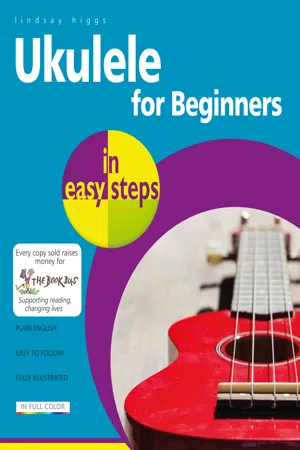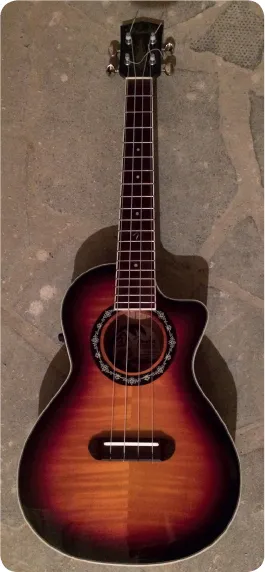
- English
- ePUB (mobile friendly)
- Available on iOS & Android
eBook - ePub
Ukulele for Beginners in easy steps
About this book
Ukulele for Beginners in easy steps shows the reader everything they need to know to get started playing a ukulele, including:
- Choosing, buying, tuning, and looking after a ukulele.
- Learning chords and how to read chord charts.
- Writing and reading tablature, and basic music reading.
- Strumming patterns and fingerpicking techniques.
- Scales and practising.
- Understanding different musical styles.
- Writing songs.
- How to find a teacher and groups to join to take playing further.
Includes over 30 exercises to develop the reader's playing, and over 40 pieces of music to practice with.
Ideal for the novice musician!
Frequently asked questions
Yes, you can cancel anytime from the Subscription tab in your account settings on the Perlego website. Your subscription will stay active until the end of your current billing period. Learn how to cancel your subscription.
At the moment all of our mobile-responsive ePub books are available to download via the app. Most of our PDFs are also available to download and we're working on making the final remaining ones downloadable now. Learn more here.
Perlego offers two plans: Essential and Complete
- Essential is ideal for learners and professionals who enjoy exploring a wide range of subjects. Access the Essential Library with 800,000+ trusted titles and best-sellers across business, personal growth, and the humanities. Includes unlimited reading time and Standard Read Aloud voice.
- Complete: Perfect for advanced learners and researchers needing full, unrestricted access. Unlock 1.4M+ books across hundreds of subjects, including academic and specialized titles. The Complete Plan also includes advanced features like Premium Read Aloud and Research Assistant.
We are an online textbook subscription service, where you can get access to an entire online library for less than the price of a single book per month. With over 1 million books across 1000+ topics, we’ve got you covered! Learn more here.
Look out for the read-aloud symbol on your next book to see if you can listen to it. The read-aloud tool reads text aloud for you, highlighting the text as it is being read. You can pause it, speed it up and slow it down. Learn more here.
Yes! You can use the Perlego app on both iOS or Android devices to read anytime, anywhere — even offline. Perfect for commutes or when you’re on the go.
Please note we cannot support devices running on iOS 13 and Android 7 or earlier. Learn more about using the app.
Please note we cannot support devices running on iOS 13 and Android 7 or earlier. Learn more about using the app.
Yes, you can access Ukulele for Beginners in easy steps by Lindsay Higgs in PDF and/or ePUB format. We have over one million books available in our catalogue for you to explore.
Information
Publisher
In Easy Steps LimitedYear
2019eBook ISBN
97818407889451
Introducing the ukulele
This chapter is an introduction to the ukulele and its history, with some suggestions to help you get kitted out so that you are ready to start playing.
A potted history of the ukulele
A few notable players
Buying and looking after a ukulele
The main parts of the ukulele
Playing position
Using your hands
Summary
A potted history of the ukulele
Say hello to your little friend – a quick introduction to the ukulele
The ukulele was developed in the 1880s from a small guitar – the “Machete de Braga” – that originally came from the island of Madeira, near Portugal. The Machete was a popular souvenir amongst wealthy British tourists who visited Madeira in the 19th century, and there is a picture of Lorina Liddell, sister of Alice, the inspiration for Alice in Wonderland, playing one in the 1860s.
Portuguese sailors visiting Hawaii took the instrument with them, and these were the forebears of the modern ukulele. The name “ukulele” translates from Hawaiian as “dancing flea”, and there are a number of theories about the origin of the name. A popular one is that when they watched the sailors playing, the Hawaiians thought that their fingers looked like fleas dancing on the fingerboard. The king of Hawaii, David Kalākaua (1836-1891), should be mentioned here as well, because his love of the ukulele was one of the most important factors in cementing its popularity.

Throughout its history the ukulele has had three main peaks in popularity, with the modern one being perhaps the largest. Interestingly, each of these is linked to developments in technology. In the 1920s, the ukulele became popular through the radio and recorded sound. The second peak of popularity in the 1950s coincided with the rise of television, and the ukulele’s current popularity has coincided with the rise of the internet and social media. In part, this is probably because it is very easy to make videos of performances using hand-held devices and upload them to sites such as YouTube.

Ukulele or Ukelele?
There are a number of different spellings that seem to be widely accepted. I’ve opted for “ukulele” in this book, although I have been reliably informed that there must always be an apostrophe in front of the first letter in order to spell it correctly in Hawaiian.
There are a number of different spellings that seem to be widely accepted. I’ve opted for “ukulele” in this book, although I have been reliably informed that there must always be an apostrophe in front of the first letter in order to spell it correctly in Hawaiian.
A few notable players
This list is very much a personal choice, but here are a few suggestions of some players to check out:
Roy Smeck (1900-1994)
Known as “the wizard of the strings”, Smeck was born in 1900 in Pennsylvania and died in 1994 in New York. As well as the guitar and banjo, he was also noted as a ukulele player. His musical style was developed from a mixture of jazz, country, and Hawaiian music. His performance of the jazz tune Tiger Rag is well worth a listen. You can listen to it and watch the performance on YouTube, here:
https://youtu.be/-8fQePz4FcE
George Formby (1904-1961)
The son of a music hall entertainer, who also used the same stage name, originally Formby’s act was based on his father’s, but he began to include the ukulele in his act after he bought one from a fellow performer. At the age of 28 he recorded a number of novelty songs, and this was the beginning of a rise to international stardom, including in Soviet Russia where, apparently, his films were hugely popular. There is a story of a schoolboy who walked up and down the street outside his house in Blackpool in the 1950s but never plucked up the courage to knock on the door to ask for his autograph. It’s a shame that George Formby didn’t live a few years longer as maybe once the Beatles were popular, John Lennon could have finally got his autograph!
One of George Formby’s best-known songs is When I’m Cleaning Windows. With lyrics that were considered rather suggestive at the time, it provided light relief and became a very popular song in the tense times leading up to World War Two. You can listen to it and watch his performance on YouTube, here:
https://youtu.be/sfmAeijj5cM
May Singhi Breen (1895-1970)
As a performer, composer and arranger, Breen was an important figure in the history of the ukulele. She successfully campaigned for the American Federation of Musicians to accept the ukulele as a musical instrument in its own right rather than just a novelty, and recorded the piece Inspiration for ukulele and big band. You can watch her performance of Waitin’ Around on YouTube, here:
https://youtu.be/ZNIVgf32rxg

The internet makes it easy to enjoy performances by many of the great players of the ukulele in a way that wasn’t possible when I started playing. Listening regularly to other players and being inspired by what is possible can be an important addition to your practice time.
James Hill (born 1980)
A graduate of the music education programme started by J. Chalmers Doane in Canada in the 1970s, which used the ukulele to teach musical literacy, Hill is widely recognised as one of today’s leading players, and his performance of Billie Jean is a great example of his mastery of the ukulele. You can see the performance on YouTube, here:
https://youtu.be/2gyxeXW_2T8
Jake Shimabukuro (born 1976)
Born in Hawaii, Shimabukuro has done much to further the popularity of the ukulele, including premiering the Ukulele Concerto that was composed for him by Byron Yasui in 2015. He became famous after his version of While My Guitar Gently Weeps by George Harrison (a keen ukulele player himself) became an internet hit. You can see it on YouTube, here:
https://youtu.be/puSkP3uym5k
Israel Kamakawiwo’ole (1959-1997)
Kamakawiwo’ole, also known affectionately as “Bruddah Iz”, died at a tragically young age but managed to do much to popularise the ukulele, with performances including his version of Somewhere Over The Rainbow, which you can view on YouTube, here:
https://youtu.be/V1bFr2SWP1I
He also moved the ukulele away from its image as a novelty instrument by using it to perform a number of heartfel...
Table of contents
- Cover
- Title
- Copyright
- Contents
- 1 Introducing the ukulele
- 2 Getting started
- 3 Swapping between chords
- 4 The three-chord trick
- 5 Moving on
- 6 A minor diversion
- 7 More minor
- 8 Put it on the tab
- 9 Stepping onwards
- 10 Jostling for position
- 11 Walking into a bar
- 12 Finger and thumb keep moving
- 13 Reading the dots
- 14 Different strokes for different folks
- 15 Taking it further
- 16 Chord shapes & scales
- Back Cover